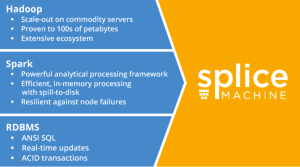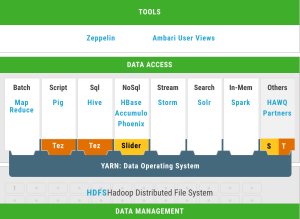Archive
Top 5 Big Data Platform predictions for 2017
The Rise of Data Science Notebooks
Apache Zeppelin is a web-based notebook that enables interactive data analytics. You can make beautiful data-driven, interactive and collaborative documents with SQL, Scala or Python and more. However Apache Zeppelin is still an incubator project, I expect a serious boost of notebooks like Apache Zeppelin on top of data processing (like Apache Spark) and data storage (like HDFS, NoSQL and also RDBMS) solutions. Read more on my previous post.
Splice Machine replace traditional RDBMSs
Splice Machine delivers an open-source database solution that incorporates the proven scalability of Hadoop, the standard ANSI SQL and ACID transactions of an RDBMS, and the in-memory performance of Apache Spark.
Machine Learning as a Service (MLaaS)
Machine Learning is the subfield of computer science that “gives computers the ability to learn without being explicitly programmed”. Within the field of data analytics, Machine Learning is a method used to devise complex models and algorithms that lend themselves to prediction; this is known as predictive analytics. The rise of Machine Learning as a Service (MLaaS) model is good news for the market, because it reduce the complexity and time required to implement Machine Learning and opens the doors to increase the adoption level. One of the companies that provide MLaaS is Microsoft with Azure ML.
Apache Spark on Kubernetes with Red Hat OpenShift
OpenShift is Red Hat‘s Platform-as-a-Service (PaaS) that allows developers to quickly develop, host, and scale applications in a cloud environment. OpenShift is a perfect platform for building data-driven applications with microservices. Apache Spark can be made natively aware of Kubernetes with OpenShift by implementing a Spark scheduler backend that can run Spark application Drivers and bare Executors in Kubernetes pods. See more on the OpenShift Commons Big Data SIG #2 blog.
MapR-FS instead of HDFS
If you’re familiar with the HDFS architecture, you’ll know about the NameNode concept, which is a separate server process that handles the locations of files within your clusters. MapR-FS doesn’t have such a concept, because all that information is embedded within all the data nodes, so it’s distributed across the cluster. The second architectural difference is the fact that MapR is written in native code and talks to directly to disk. HDFS (written in Java) runs in the JVM and then talk to a Linux file system before it talks to disks, so you have a few layers there that will impact performance and scalability. Read more differences in the MapR-FS vs. HDFS blog.
Apache Zeppelin “the notebook” on top of all the (Big) Data
Apache Zeppelin is a web-based notebook that enables interactive data analytics. You can make beautiful data-driven, interactive and collaborative documents with SQL, Scala or Python and more. However Apache Zeppelin is still an incubator project, I expect a serious boost of notebooks like Apache Zeppelin on top of data processing (like Apache Spark) and data storage (like HDFS, NoSQL and also RDBMS) solutions.
But is Apache Zeppelin covered in the current Hadoop distributions Cloudera, Hortonworks and MapR?
Cloudera is not covering Apache Zeppelin out of the box, but there is blog post how to install Apache Zeppelin on CDH. Hortonworks is covering Apache Zeppelin out of the box, see the picture of the HDP projects (well done Hortonworks). MapR is not covering Apache Zeppelin out of the box, but there is a blog post how to build Apache Zeppelin on MapR.
Is Apache Zeppelin covered by the greatest cloud providers Amazon AWS, Microsoft Azure and Google Cloud Platform?
We see that Amazon Web Services (AWS) has a Platform as a Service solution (PaaS) called Elastic Map Reduce (EMR). We see that since this summer Apache Zeppelin is supported on the EMR release page.
If we look at Microsoft Azure, there is a blog post how to start with Apache Zeppelin on the HD Insights Spark Cluster (this is a also a PaaS solution).
If we look at Google Cloud Platform we see a blog post to install Apache Zeppelin on top of Google BigQuery.
And now a short demo, lets do some data discovery with Apache Zeppelin on an open data set. For this case I use the Fire Report from the City of Amsterdam from 2010 – 2015.
If you want a short intro look first at this short video of Apache Zeppelin (overview).
I use of course docker to start a Zeppelin container. I found an image in the docker hub from Dylan Meissner (thx). Run the docker container to enter the command below:
$ docker run -d -p 8080:8080 dylanmei/zeppelin
Look in the browser at dockerhost:8080 and create a new notebook:
Step 1: Load and unzip the dataset (I use the “shell” interpreter)
%sh wget https://files.datapress.com/amsterdam/dataset/brandmeldingen-2010-2015/2016-02-25T14:51:13/brwaa_2010-2015.zip -O /tmp/brwaa_2010-2015.zip
%sh unzip /tmp/brwaa_2010-2015.zip -d /tmp
Step 2: Clean the data, in this case remove the header
%sh sed -i '1d' /tmp/brwaa_2010-2015.csv
Step 3: Put data into HDFS
%sh hadoop fs -put /tmp/brwaa_2010-2015.csv /tmp
Step 4: Load the data (most import fields) via a class and use the map function (default Scala)
val dataset=sc.textFile("/tmp/brwaa_2010-2015.csv")
case class Melding (id: Integer, melding_type: String, jaar: String, maand_nr: String, prioriteit: String, uur: String, dagdeel: String, buurt: String, wijk: String, gemeente: String)
val melding = dataset.map(k=>k.split(";")).map(
k => Melding(k(0).toInt,k(2),k(7),k(8),k(14),k(15),k(16),k(19),k(20),k(22))
)
melding.toDF().registerTempTable("melding_table")
Step 5: Use Spark SQL to run the first query
%sql select count(*) from melding_table
Below you can see some more queries and charts:
Next step is how to predict fire with help of Spark ML.



